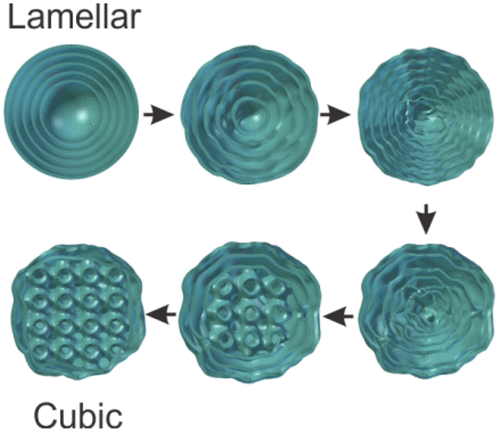当前位置:
X-MOL 学术
›
J. Phys. Chem. Lett.
›
论文详情
Our official English website, www.x-mol.net, welcomes your
feedback! (Note: you will need to create a separate account there.)
Direct Visualization of the Structural Transformation between the Lyotropic Liquid Crystalline Lamellar and Bicontinuous Cubic Mesophase
The Journal of Physical Chemistry Letters ( IF 4.8 ) Pub Date : 2018-05-29 00:00:00 , DOI: 10.1021/acs.jpclett.8b01110 Nhiem Tran 1, 2, 3 , Jiali Zhai 1, 2 , Charlotte E. Conn 1 , Xavier Mulet 2 , Lynne J. Waddington 2 , Calum J. Drummond 1
The Journal of Physical Chemistry Letters ( IF 4.8 ) Pub Date : 2018-05-29 00:00:00 , DOI: 10.1021/acs.jpclett.8b01110 Nhiem Tran 1, 2, 3 , Jiali Zhai 1, 2 , Charlotte E. Conn 1 , Xavier Mulet 2 , Lynne J. Waddington 2 , Calum J. Drummond 1
Affiliation

|
The transition between the lyotropic liquid crystalline lamellar and the bicontinuous cubic mesophase drives multiple fundamental cellular processes involving changes in cell membrane topology, including endocytosis and membrane budding. While several theoretical models have been proposed to explain this dynamic transformation, experimental validation of these models has been challenging because of the short-lived nature of the intermediates present during the phase transition. Herein, we report the direct observation of a lamellar-to-bicontinuous cubic phase transition in nanoscale dispersions using a combination of cryogenic transmission electron microscopy and static small-angle X-ray scattering. The results represent the first experimental confirmation of a theoretical model which proposed that the bicontinuous cubic phase originates from the center of a lamellar vesicle then propagates outward via the formation of interlamellar attachments and stalks. The observation was possible because of the precise control of the lipid composition to place the dispersion systems at the phase boundary of a lamellar and a cubic phase, allowing for the creation of long-lived structural intermediates. By the surveying of the nanoparticles using cryogenic transmission electron microscopy, a complete phase transition sequence was established.
中文翻译:

溶致液晶层状和双连续立方中间相之间结构转变的直接可视化
溶致液晶层和双连续立方中间相之间的过渡驱动了多个基本的细胞过程,这些过程涉及细胞膜拓扑的变化,包括内吞作用和膜出芽。虽然已经提出了几种理论模型来解释这种动态转化,但是由于在相变过程中存在的中间体具有短暂的寿命,因此对这些模型进行实验验证仍然具有挑战性。在这里,我们报告使用低温透射电子显微镜和静态小角X射线散射相结合,直接观察到纳米级分散体中的层状到双连续立方相变。结果代表理论模型的第一个实验证实,该理论模型提出双连续立方相起源于层状囊泡的中心,然后通过层间附着和茎的形成向外传播。由于可以精确控制脂质组成,将分散体系置于层状相和立方相的相界,从而形成了长寿命的结构中间体,因此可以进行观察。通过使用低温透射电子显微镜调查纳米颗粒,建立了完整的相变序列。由于可以精确控制脂质组成,将分散体系置于层状相和立方相的相界,从而形成了长寿命的结构中间体,因此可以进行观察。通过使用低温透射电子显微镜调查纳米颗粒,建立了完整的相变序列。由于可以精确控制脂质组成,将分散体系置于层状相和立方相的相界,从而形成了长寿命的结构中间体,因此可以进行观察。通过使用低温透射电子显微镜调查纳米颗粒,建立了完整的相变序列。
更新日期:2018-05-29
中文翻译:

溶致液晶层状和双连续立方中间相之间结构转变的直接可视化
溶致液晶层和双连续立方中间相之间的过渡驱动了多个基本的细胞过程,这些过程涉及细胞膜拓扑的变化,包括内吞作用和膜出芽。虽然已经提出了几种理论模型来解释这种动态转化,但是由于在相变过程中存在的中间体具有短暂的寿命,因此对这些模型进行实验验证仍然具有挑战性。在这里,我们报告使用低温透射电子显微镜和静态小角X射线散射相结合,直接观察到纳米级分散体中的层状到双连续立方相变。结果代表理论模型的第一个实验证实,该理论模型提出双连续立方相起源于层状囊泡的中心,然后通过层间附着和茎的形成向外传播。由于可以精确控制脂质组成,将分散体系置于层状相和立方相的相界,从而形成了长寿命的结构中间体,因此可以进行观察。通过使用低温透射电子显微镜调查纳米颗粒,建立了完整的相变序列。由于可以精确控制脂质组成,将分散体系置于层状相和立方相的相界,从而形成了长寿命的结构中间体,因此可以进行观察。通过使用低温透射电子显微镜调查纳米颗粒,建立了完整的相变序列。由于可以精确控制脂质组成,将分散体系置于层状相和立方相的相界,从而形成了长寿命的结构中间体,因此可以进行观察。通过使用低温透射电子显微镜调查纳米颗粒,建立了完整的相变序列。











































 京公网安备 11010802027423号
京公网安备 11010802027423号